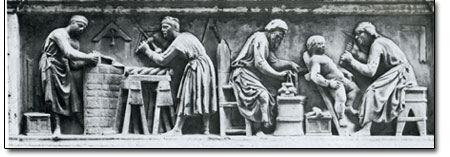|
| ||
| Agent of change
by Jules Masterjohn “A laborer is one who makes something with his hands. A craftsperson is one who makes something with his hands and mind. An artist is someone who makes something with his hands, mind and heart.” – From a woodworker’s blog This quote offers one overview of the distinctions among the makers of things. Some would not agree with this summary, and many are weary of even making these distinctions. The art vs. craft debate has fueled many hot conversations that reveal varying opinions. The conversations often emerge unresolved, the topic a slippery slope into historical and present day divisions. This discussion is timely due to the abundance of makers – potters, jewelers, weavers and others working with time-honored craft media – who, this time of year, depend upon selling their work to sustain their livelihoods. They are readily termed “artists” because they make things. As an occasional maker myself, I understand this label of convenience. As an arts educator and writer, however, I find myself challenged by this too-easy distinction. How do I make a case for Michelangelo and the potter down the street both being called artists? To approach this topic in less than 1,000 words, I call on the aid of a few thinkers and writers who have, wide-eyed, fully gazed into this Pandora’s box. I will merely pry it open a wee bit. Throughout history, different labels have been used to describe certain kinds of makers. The notion of “artist” as an independent agent of artistic expression is fairly recent, arising during the 18th century. The concept of this modern artist may have been established in ancient Greece, where the names of sculptors, vase painters and architects were documented for the first time in history. Their activity was elevated, though their social status was not. In his book, The Artist, published in 1982, Thomas Burke Feldman tells the story of makers throughout time. He clarifies that, in ancient Greece, there were two kinds of “techne,” or making. One was “praxis,” or ordinary making, the manual labor of the “slave class.” The other, involved “poesis” (as in poetry) or inspired making. “Sophia,” or inner knowledge, directed the poet and but not the makers of things. This would appear later. Feldman believes that inspiration became part of the artistic process during the Renaissance, which “established a tradition that artists were interested in the inquiry involved in making a painting or sculpture, not simply the technical execution.” Breaking from class barriers, an artist could be seen as an intellectual, joining in upper class interests and socializing with his patrons, the wealthy and powerful merchants and popes. Yet, artists still used their hands. A sculptor could be rebuked as a common laborer, covered in dust and using the crude tools of his trade. Prior to the Renaissance, during the Middle Ages, the person carving cathedral sculptures or fashioning the jeweled crown for the Holy Roman emperor were considered “craftsmen” – and I do mean men. They slavishly followed the established conventions of their trades and the tastes of their patrons, the ruling elite. The “artisan” moniker came about as those engaged in the crafts joined together into guilds during the late Middle Ages, and a hierarchy within each craft or trade developed to ensure quality. Though still governed by the traditions within each craft, the independence of the guilds helped to nurture the idea of individual vision and slowly, innovation began to creep into the artisan’s consciousness. The notion of “the artist” evolved over time. In The Invention of Art, author Larry Shiner describes a “break” from the old ideas of the artisan employing “grace, invention and imagination.” By the 18th century, these qualities were solely attributed to the artist. After this rupture from the more traditional concept, the artisan/craftsperson “was said to possess only skill, to work by rule, and care primarily for money.” Herein lies, perhaps, the foundation of our current division between art and craft. Out of the period of the 17th through the early 19th centuries, which is often referred to as an era of revolutions, came a refinement in how artists saw their role in society. Feldman writes, “Artists, and thoughtful people in general, realized that they could play a role in the shaping of human destiny.” His reference marks the beginning of artists making a “determined effort at self-transformation” and entering the “process of radical social change.” From our 21st century perspective, considering the evolution of the role of the artist, I would offer that to be called an artist today means being an agent of change, a true creator. A maker who is aware one’s place within the continuum of history and uses one’s practice to transform oneself. By removing one’s own blinders, the artist’s activity aids in bringing about a wholly conscious society. From this current view, I would add the following distinction to the opening quote: Creators make something with their hands, minds and/or hearts, while possessing full awareness of the power, responsibility and magic they hold. • This article is dedicated to Peggy Maloney, local jeweler and former FLC instructor, who died in a car accident on Thanksgiving Day. A celebration of her life will be held at 2 p.m. this Sun., Dec. 7, at the Durango Arts Center.
|


